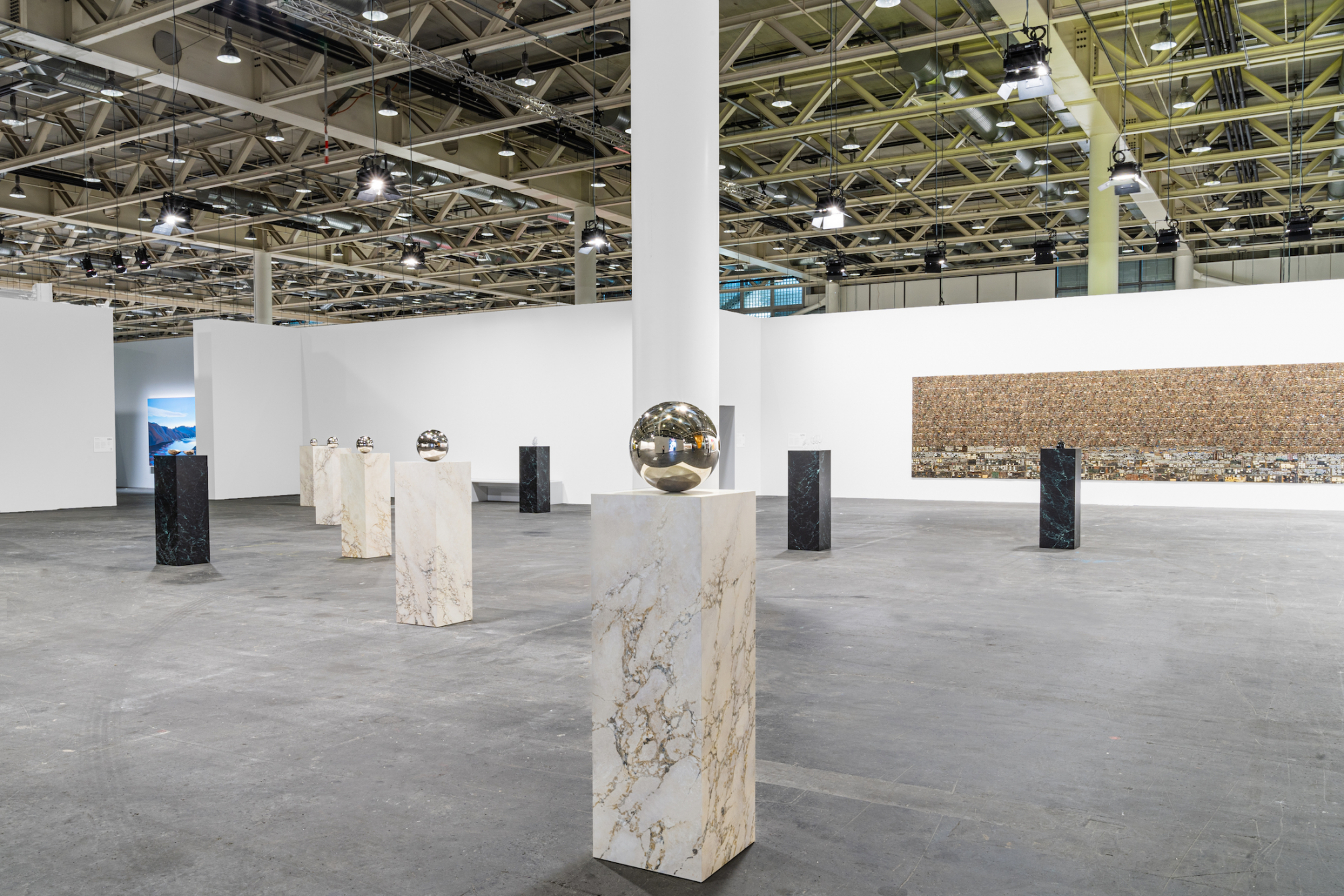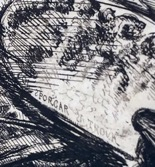Cultural Currency 14: Kimura Yuki "COL SPORCAR SI TROVA" @ Unlimited, Art Basel
Photos not taken, architecture not built (Part 2)
By Shimizu Minoru
2023.07.18

Courtesy of Galerie Chantal Crousel and Taka Ishii Gallery / Photo: Jiayun Deng
The title of the exhibition, “COL SPORCAR SI TROVA,” refers to a phrase adopted as a mantra by Piranesi in opposition to a Winckelmannesque aesthetic of Greece worship/Idea worship. Because it is written on the edge of a copperplate print palette, I originally thought it meant, “If you move the brush appropriately, you will find (the shape you are seeking),” but the standard English translation is apparently, “By messing about, one discovers.” In other words, if you stroll around the Unlimited venue without necessarily looking for anything, you will at some point (because there are no barriers or partitions) walk into Kimura’s installation, and while wandering from pedestal to pedestal you will make discoveries.
 But Kimura’s installation is not a maze. Once inside, one notices that silver balls sit atop five white marble (-like) pedestals, and that these are arranged in a single row giving the installation an axis. Furthermore, if one looks from one end of this axis, the five balls recede from large to small, but if one looks from the opposite end the balls appear to be the same size. This is the same principle as that used in the Palazzo Spada in Rome, famous for its forced perspective optical illusion. The mirror balls reflect the surrounding space like fisheye lenses, but because the ratios are all the same, the reflected spaces in the large balls are not large, and those in the small balls not small. There is also a black marble (-like) pedestal on which a set of four gin bottles (large) is placed, and a pedestal on which an identical set of four gin bottles (small) is placed. It seems that the theme is “size.” Enlargement and reduction? Furthermore, the moment one notices that these two pedestals are in bilaterally symmetric positions on either side of the mirror ball axis, the entire installation immediately takes on the appearance of a square field with this axis as a diagonal. On top of the other pedestals are placed identical glasses, plates, shells and penholders, also in sizes large to small. Trompe l’oeil, glasses, shells, pens… Flemish still lifes? Matryoshka dolls? Black and white?… For those who might raise a smart phone with the intention of taking a photo, a surprise awaits. When everything fits inside the frame, the differences in size one experienced up till then completely disappear.
But Kimura’s installation is not a maze. Once inside, one notices that silver balls sit atop five white marble (-like) pedestals, and that these are arranged in a single row giving the installation an axis. Furthermore, if one looks from one end of this axis, the five balls recede from large to small, but if one looks from the opposite end the balls appear to be the same size. This is the same principle as that used in the Palazzo Spada in Rome, famous for its forced perspective optical illusion. The mirror balls reflect the surrounding space like fisheye lenses, but because the ratios are all the same, the reflected spaces in the large balls are not large, and those in the small balls not small. There is also a black marble (-like) pedestal on which a set of four gin bottles (large) is placed, and a pedestal on which an identical set of four gin bottles (small) is placed. It seems that the theme is “size.” Enlargement and reduction? Furthermore, the moment one notices that these two pedestals are in bilaterally symmetric positions on either side of the mirror ball axis, the entire installation immediately takes on the appearance of a square field with this axis as a diagonal. On top of the other pedestals are placed identical glasses, plates, shells and penholders, also in sizes large to small. Trompe l’oeil, glasses, shells, pens… Flemish still lifes? Matryoshka dolls? Black and white?… For those who might raise a smart phone with the intention of taking a photo, a surprise awaits. When everything fits inside the frame, the differences in size one experienced up till then completely disappear.
 Every medium, as long as it is a medium—ie a medium between things—has physical resistance as a “thing.” An artist’s hands and eyes overcome this resistance by assimilating each medium, thereby realizing free expression, but this is merely a case of the person using it having become familiar with the medium and does not concern media as things. In other words, a medium always contains a singularity that eludes the acclimatization of a person’s hands and eyes and undermines the illusion of “freedom.” This is the point where a medium regains its otherness as a “thing.”
Every medium, as long as it is a medium—ie a medium between things—has physical resistance as a “thing.” An artist’s hands and eyes overcome this resistance by assimilating each medium, thereby realizing free expression, but this is merely a case of the person using it having become familiar with the medium and does not concern media as things. In other words, a medium always contains a singularity that eludes the acclimatization of a person’s hands and eyes and undermines the illusion of “freedom.” This is the point where a medium regains its otherness as a “thing.”
For photography, “size” is just such a singularity, with “life-size” being a giddiness peculiar to photography. From the age of the camera obscura (the age of Flemish still lifes and the age of trompe l’oeil!), we have gotten to know and love photographic images as media in which reality is projected onto and fixed to a plane. However, through these photographic images, the inherent “size” that a real entity always has is lost and relativized. For this reason, for photography, “life-size” in which the opposite ends of a lens are connected with an equal sign is a kind of blind spot. Due to the entity and its image being made equal, the photograph tears itself away from the plane, as it were, recovering the essential otherness of photography as multiple incarnations of an irreplaceable single existence.
 Because Kimura’s objects are all real things, they are all “life-size.” However, because they appear in a number of different sizes from smallest to largest, or are different sizes but appear the same size (the mirror balls), their inherent “size” is undermined and a situation similar to being in a photograph arises. Here, in order to express the essence of photography, which has no “size” dimension and whose blind spot is “life-size,” there is no need to take photographs. To put it the other way around, a photograph-like situation in which the dimension of size disappears arises without things being in a photograph. The ambiguity of the dimension of size is probably linked to the ambiguity of spatial awareness. In Dusseldorf, the gallery space was painted to create lateral black and white stripes [the wall painting Stripe (2022)], both nullifying the existing walls and beams and more clearly partitioning and closing off the exhibition space. At Unlimited, due to the arrangement of the pedestals and the size correspondence of the objects, an exhibition space formed after the fact.
Because Kimura’s objects are all real things, they are all “life-size.” However, because they appear in a number of different sizes from smallest to largest, or are different sizes but appear the same size (the mirror balls), their inherent “size” is undermined and a situation similar to being in a photograph arises. Here, in order to express the essence of photography, which has no “size” dimension and whose blind spot is “life-size,” there is no need to take photographs. To put it the other way around, a photograph-like situation in which the dimension of size disappears arises without things being in a photograph. The ambiguity of the dimension of size is probably linked to the ambiguity of spatial awareness. In Dusseldorf, the gallery space was painted to create lateral black and white stripes [the wall painting Stripe (2022)], both nullifying the existing walls and beams and more clearly partitioning and closing off the exhibition space. At Unlimited, due to the arrangement of the pedestals and the size correspondence of the objects, an exhibition space formed after the fact.

 Come to think of it, this act of changing the space by changing the sizes of the works could also be seen at the 2019 solo exhibition “Reception” (Taka Ishii Gallery, August 3–September 7, 2019). By presenting miniatures of the counter table that were exactly the same as the original in terms of their construction but reduced respectively to scales of 75%, 50% and 25%, Kimura intervened in the audience’s spatial perception. In other words, Kimura’s installations concerning “size” are not only photos not taken, but also architecture not built.
Come to think of it, this act of changing the space by changing the sizes of the works could also be seen at the 2019 solo exhibition “Reception” (Taka Ishii Gallery, August 3–September 7, 2019). By presenting miniatures of the counter table that were exactly the same as the original in terms of their construction but reduced respectively to scales of 75%, 50% and 25%, Kimura intervened in the audience’s spatial perception. In other words, Kimura’s installations concerning “size” are not only photos not taken, but also architecture not built.
—————————————————————
Shimizu Minoru
Critic. Professor, Doshisha University.

From the brochure for the Dusseldorf exhibition “COL SPORCAR SI TROVA,” p.101

Yuki Kimura, COL SPORCAR SI TROVA, installation view at Unlimited, Art Basel, Jun 15–18, 2023.
Courtesy of Galerie Chantal Crousel and Taka Ishii Gallery / Photo: Jiayun Deng
For photography, “size” is just such a singularity, with “life-size” being a giddiness peculiar to photography. From the age of the camera obscura (the age of Flemish still lifes and the age of trompe l’oeil!), we have gotten to know and love photographic images as media in which reality is projected onto and fixed to a plane. However, through these photographic images, the inherent “size” that a real entity always has is lost and relativized. For this reason, for photography, “life-size” in which the opposite ends of a lens are connected with an equal sign is a kind of blind spot. Due to the entity and its image being made equal, the photograph tears itself away from the plane, as it were, recovering the essential otherness of photography as multiple incarnations of an irreplaceable single existence.

Yuki Kimura Stripe, 2022, wall painting, black and white 263mm stripes, 450 x 3445 x 950 cm
Installation view Kunstverein für die Rheinlande und Westfalen, Düsseldorf, 2022.
Courtesy of Kunstverein für die Rheinlande und Westfalen, Düsseldorf and Taka Ishii Gallery / Photo: Cedric Mussano


Yuki Kimura “Reception,” installation views at Taka Ishii Gallery Tokyo, Aug 3–Sep 7, 2019.
Courtesy of Taka Ishii Gallery / Photos: Yasushi Ichikawa
—————————————————————
Shimizu Minoru
Critic. Professor, Doshisha University.